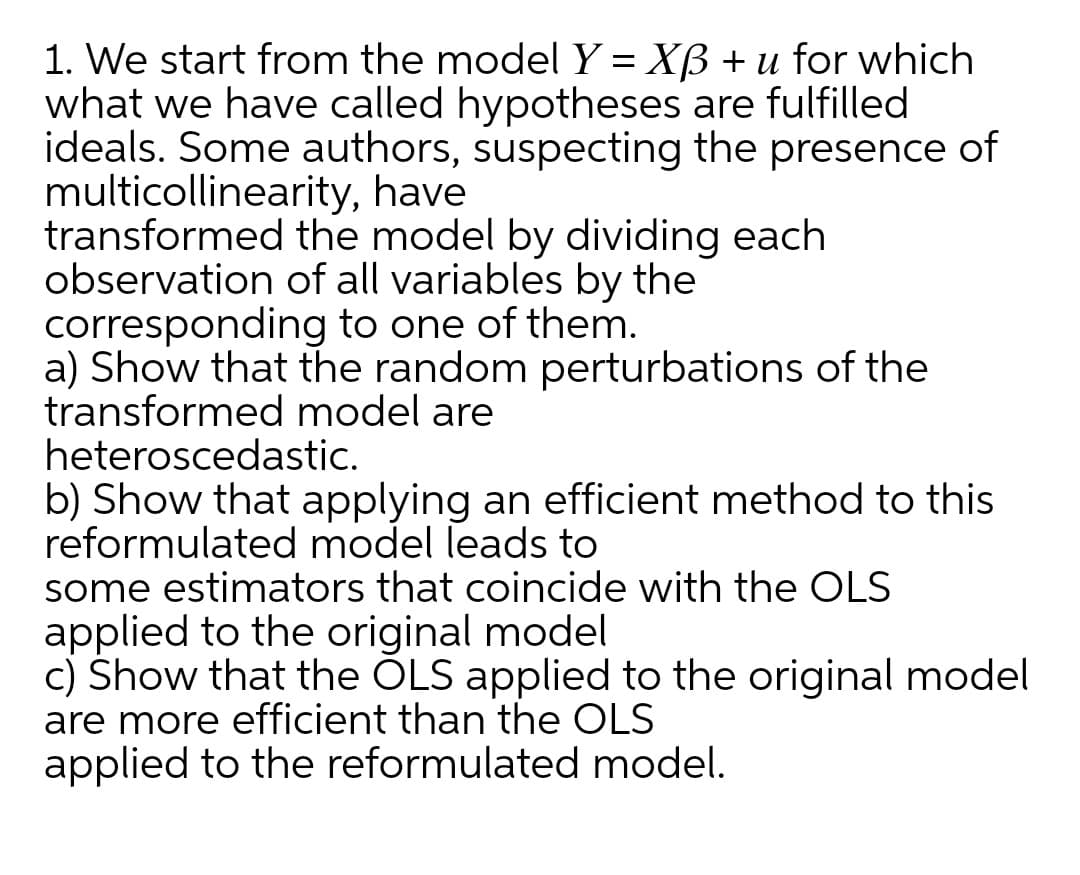1. We start from the model Y = Xß + u for which what we have called hypotheses are fulfilled ideals. Some authors, suspecting the presence of multicollinearity, have transformed the model by dividing each observation of all variables by the corresponding to one of them. a) Show that the random perturbations of the transformed model are heteroscedastic. b) Show that applying an efficient method to this reformulated model leads to some estimators that coincide with the OLS applied to the original model c) Show that the ÕLS applied to the original model are more efficient than the OLS applied to the reformulated model.
1. We start from the model Y = Xß + u for which what we have called hypotheses are fulfilled ideals. Some authors, suspecting the presence of multicollinearity, have transformed the model by dividing each observation of all variables by the corresponding to one of them. a) Show that the random perturbations of the transformed model are heteroscedastic. b) Show that applying an efficient method to this reformulated model leads to some estimators that coincide with the OLS applied to the original model c) Show that the ÕLS applied to the original model are more efficient than the OLS applied to the reformulated model.
MATLAB: An Introduction with Applications
6th Edition
ISBN:9781119256830
Author:Amos Gilat
Publisher:Amos Gilat
Chapter1: Starting With Matlab
Section: Chapter Questions
Problem 1P
Related questions
Question

Transcribed Image Text:1. We start from the model Y = Xß + u for which
what we have called hypotheses are fulfilled
ideals. Some authors, suspecting the presence of
multicollinearity, have
transformed the model by dividing each
observation of all variables by the
corresponding to one of them.
a) Show that the random perturbations of the
transformed model are
heteroscedastic.
b) Show that applying an efficient method to this
reformulated model leads to
some estimators that coincide with the OLS
applied to the original model
c) Show that the ÕLS applied to the original model
are more efficient than the OLS
applied to the reformulated model.
Expert Solution
This question has been solved!
Explore an expertly crafted, step-by-step solution for a thorough understanding of key concepts.
Step by step
Solved in 4 steps

Knowledge Booster
Learn more about
Need a deep-dive on the concept behind this application? Look no further. Learn more about this topic, statistics and related others by exploring similar questions and additional content below.Recommended textbooks for you

MATLAB: An Introduction with Applications
Statistics
ISBN:
9781119256830
Author:
Amos Gilat
Publisher:
John Wiley & Sons Inc

Probability and Statistics for Engineering and th…
Statistics
ISBN:
9781305251809
Author:
Jay L. Devore
Publisher:
Cengage Learning

Statistics for The Behavioral Sciences (MindTap C…
Statistics
ISBN:
9781305504912
Author:
Frederick J Gravetter, Larry B. Wallnau
Publisher:
Cengage Learning

MATLAB: An Introduction with Applications
Statistics
ISBN:
9781119256830
Author:
Amos Gilat
Publisher:
John Wiley & Sons Inc

Probability and Statistics for Engineering and th…
Statistics
ISBN:
9781305251809
Author:
Jay L. Devore
Publisher:
Cengage Learning

Statistics for The Behavioral Sciences (MindTap C…
Statistics
ISBN:
9781305504912
Author:
Frederick J Gravetter, Larry B. Wallnau
Publisher:
Cengage Learning

Elementary Statistics: Picturing the World (7th E…
Statistics
ISBN:
9780134683416
Author:
Ron Larson, Betsy Farber
Publisher:
PEARSON

The Basic Practice of Statistics
Statistics
ISBN:
9781319042578
Author:
David S. Moore, William I. Notz, Michael A. Fligner
Publisher:
W. H. Freeman

Introduction to the Practice of Statistics
Statistics
ISBN:
9781319013387
Author:
David S. Moore, George P. McCabe, Bruce A. Craig
Publisher:
W. H. Freeman